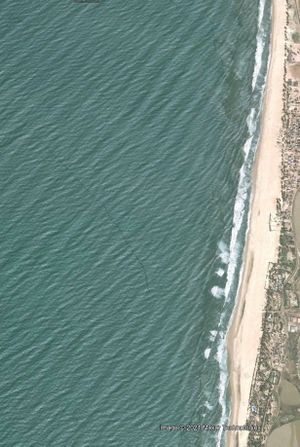Difference between revisions of "Refraction"
From Coastal Wiki
Dronkers J (talk | contribs) |
Dronkers J (talk | contribs) |
||
| Line 13: | Line 13: | ||
Wave refraction at any location <math>(x,y)</math> is described by Snell's law | Wave refraction at any location <math>(x,y)</math> is described by Snell's law | ||
| − | <math>\Large\frac{\sin \theta}{c}\normalsize = constant .</math> | + | <math>\Large\frac{\sin \theta}{c}\normalsize = constant . \qquad (1)</math> |
Here is <math>\theta</math> the direction of a wave ray and <math>c</math> the wave propagation speed. | Here is <math>\theta</math> the direction of a wave ray and <math>c</math> the wave propagation speed. | ||
| − | Refraction and [[diffraction]] have to be considered together<ref>Huntley, D.A. and Bryan, K.R. 2022. Waves. Chapter 8.03, Treatise on Geomorphology 2nd edition. Elsevier</ref> | + | Refraction and [[diffraction]] have to be considered together<ref>Huntley, D.A. and Bryan, K.R. 2022. Waves. Chapter 8.03, Treatise on Geomorphology 2nd edition. Elsevier</ref>. See Komar 1998<ref>Komar, P.D. 1998. Beach Processes and Sedimentation. Prentice-Hall</ref> for the construction of wave rays from Eq. (1). |
Revision as of 15:20, 30 October 2022
Definition of Refraction:
The propensity of waves to align the wave front in shallow water with the depth contour, according to Snell's law. Also: Change of wave propagation direction due to the interaction with currents.
This is the common definition for Refraction, other definitions can be discussed in the article
|
Notes
When incident waves are approaching the coast from different directions (directional spread), refraction in shallow water will bend the wave fronts such that they become aligned with the depth contours. The directional spread will thus become narrower.
Wave refraction at any location [math](x,y)[/math] is described by Snell's law
[math]\Large\frac{\sin \theta}{c}\normalsize = constant . \qquad (1)[/math]
Here is [math]\theta[/math] the direction of a wave ray and [math]c[/math] the wave propagation speed.
Refraction and diffraction have to be considered together[1]. See Komar 1998[2] for the construction of wave rays from Eq. (1).
